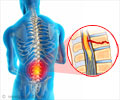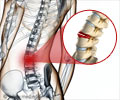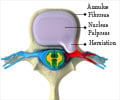What is Laminectomy?
Laminectomy is a surgical procedure undertaken to relieve symptoms caused by pressure (decompression surgery) on the spinal nerve roots due to stenosis or narrowing of the spinal canal. It involves removal of a portion of the vertebral arch posteriorly to relieve pressure on the nerve roots and travel through the spinal canal without getting compressed. It is performed only in a hospital setting.
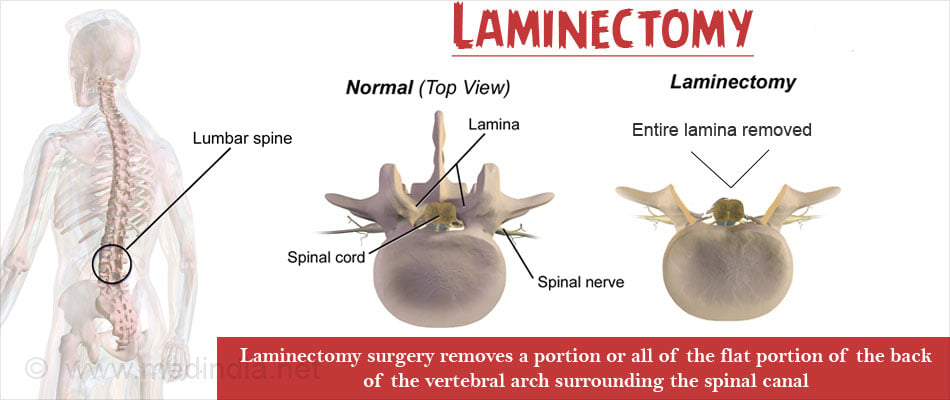
Demographics of Back Pain
- Low back pain due to lumbar vertebral disorders has been described since 3000 BC by Egyptian surgeons.
- Interestingly, low back pain ranks second to only the common cold in absence from work and makes up nearly 15% of compensation claims.
- About 70% of persons will experience low back pain at some point in their life; 1 out of 5 persons experiences some kind of back pain annually.
- It is more common between the ages of 45 and 65
- Women are more commonly affected compared to men.
- Caucasians and Hispanics are more often affected compared to Asians and African Americans.
- Nearly 13 million persons in the US seek medical attention related to back pain and 14% of new visits to the primary care physicians is related to problems of low back.
- The costs to the American economy is estimated at a staggering 75-80 billion dollars from back pain related issues.
Understanding the Anatomy of the Vertebral Column
The vertebral column in humans is made of 33 vertebrae, some of which are fused. The vertebral column is divided into 5 portions as mentioned below made of a specific number of vertebrae.
- Cervical – 7
- Thoracic – 12
- Lumbar – 5
- Sacral – 5 (fused)
- Coccygeal – 5 (fused)
Each vertebra is made of 2 laminae, that form the vertebral arch on the back surrounding the spinal cord within the spinal canal. Between consecutive vertebrae is an inter-vertebral disk, which cushions the vertebrae when the person twists or bends the spine. The spinal nerves, of which there are 31 pairs emerge from the spinal cord through openings between adjacent vertebrae (inter-vertebral foramina).
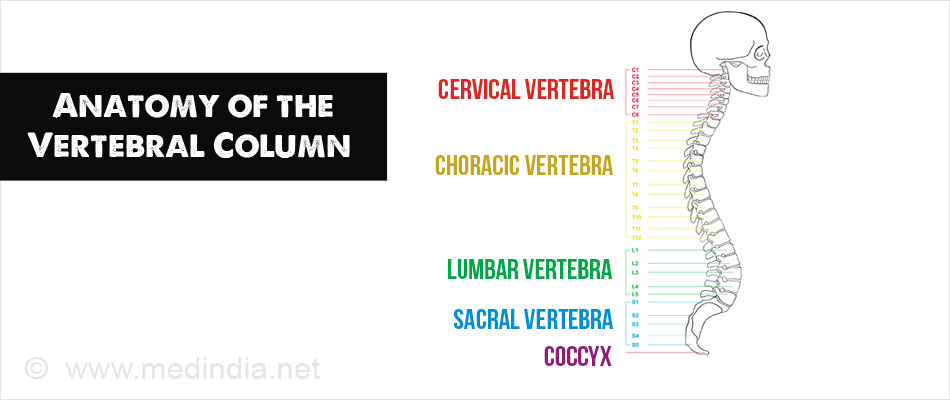
What are the Types of Laminectomy?
Laminectomy is divided into three types namely
- Traditional open laminectomy
- Hemilaminectomy
- Laminotomy
Traditional or conventional laminectomy is an open back surgery. Although relatively a safe procedure but there are some risks involved. The incision is relatively large on the back and involves cutting through muscles and connective tissue. The risks include -
- Inadvertent Nerve injury
- Leakage of Spinal fluid
- Formation of scar tissue,
- Infection and
- Blood loss.
The surgery also requires an extended period of stay in the hospital and a prolonged recovery period.
Hemilaminectomy involves removal of lamina only on one side.
Laminotomy involves removal of only a small portion of the lamina as opposed to laminectomy, and achieves pretty much similar results. It can also be performed as a minimally invasive procedure with much less postoperative morbidity. The incision is smaller and it can also be done through endoscopes.
A more conservative approach and doing a minimal surgery is now becoming more popular. However it does require an experienced orthopedic or neurosurgeon to perform it.
Additionally, laminectomy is subdivided into cervical and lumbar laminectomy, depending on the region of the spine affected and operated upon.
Why is Laminectomy Performed?
As mentioned earlier, laminectomy is performed for a wide variety of reasons that cause compression of nerve roots within the spinal canal.
Disk herniation or degeneration or spinal disease can affect the vertebrae in the cervical or the lumbar region. If the cervical region is affected, the pain and numbness affects the upper limbs, while lumbar vertebral disease causes pain and symptoms in the lower limbs.
Laminectomy surgery is generally considered as an option only if the patient has failed to respond to other forms of treatment such as pain relief medications and spinal nerve root injections, and severe pain causing disruption of the quality of one’s life.
Presence of symptoms of nerve damage such as weakness and numbness is also an indication for surgery.
The reasons for laminectomy include-
- Disk herniation
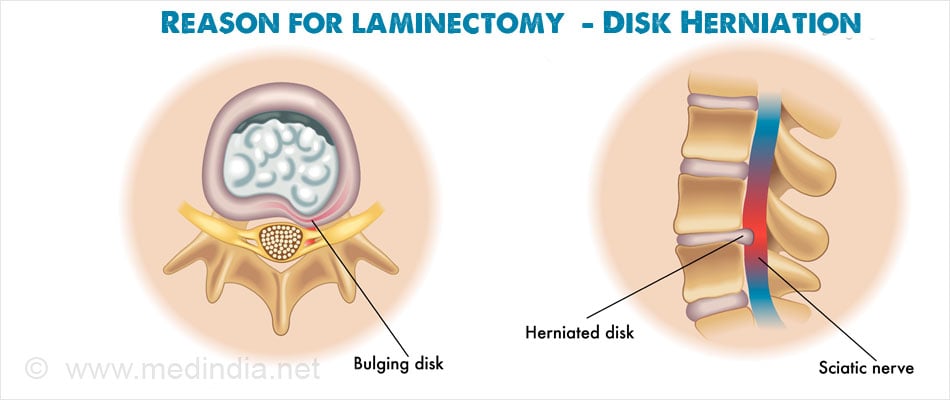
- Degenerative disk disease
- Spinal stenosis or narrowing of the spinal canal
- Sciatica or shooting pain down the back of legs
- Ankylosing spondylitis
- Osteoarthritis or degeneration of the joints of spine
What is the Preparation for Undergoing a Laminectomy Procedure?
The following precautions are generally followed before undertaking any surgical procedure.
- The procedure is explained to the patient, who is thereby given an opportunity to voice any concerns or doubts he or she may have.
- Getting a thorough history of prior and current illnesses and list of medications, history of drug allergies, and previous surgeries.
- Thorough physical examination to rule out any abnormalities
- Lab tests including blood and urine tests, chest x-ray and ECG.
- Tests to measure kidney and liver function
- Tests to detect bleeding or clotting abnormalities
- Aspirin and pain relief medications should be stopped for 7-10 days before surgery as they interfere with clotting.
- Patient is advised to stop smoking for a week before surgery
- It may be necessary to consult a physical therapist to discuss post-operative rehabilitation.
- No food or liquid is allowed orally for at least 8 hours before the procedure
- A sedative might be given the night before the procedure
- Excess hair present on the surgical area may be shaved off.
- Depending on the patient’s condition, certain specific precautions or preparations may be advised by the surgeon
What Happens During the Laminectomy Procedure?
The laminectomy operation is done in a hospital by a qualified and skilled surgeon. The procedure might take a couple of hours.
The surgery is done under general anesthesia when the patient is asleep. Under spinal anesthesia the patient is awake but has no sensation below the waist. Certain techniques are now available that permit the procedure to be performed under local anesthesia as an outpatient procedure. The options available will be discussed by the doctor with the patient.
- The patient is given a sterile gown to wear and positioned either face down or on the side and an intravenous line is started.
- After administration of the anesthetic, the patient’s vital signs such as heart rate, blood pressure and respiration are continuously monitored by the anesthetist.
- The skin over the surgical area is cleaned with sterile antiseptic solution.
- The surgeon places an incision over the affected vertebra and retracts the muscles to reach the lamina (posterior part of the vertebral arch).
- A part or whole of the lamina, any bony abnormalities or spurs may be removed to relieve pressure on the affected nerve roots.
- If a large amount of bone has been removed, a spinal fusion may be performed to stabilize the spine.
- The incision is closed using staples or stitches and the wound is covered with a dressing.
What Happens After the Procedure?
In the Hospital
- After the operation, the patient is shifted to recovery. The patient is required to stay in the hospital for a minimum of 3 to 5 days.
- Intravenous fluids are administered to maintain hydration.
- Antibiotics are also administered parenterally to prevent the risk of infection and medications are given for pain relief.

- Patient is usually made to walk within a day of the operation to reduce risk of clotting.
- Before discharge, exercises may be prescribed to follow at home.
Aftercare at Home
- Adequate rest and sleep.
- Proper diet and nutrition.
- Remaining ambulant without overstraining.
- Keeping the wound area clean and dry and following specific bathing instructions.
- Taking the prescribed medications regularly.
- Continuing the prescribed exercises.
- The doctor must be immediately consulted in the event of fever, bleeding or discharge from the surgical wound, increasing back pain, numbness over buttocks or legs, and poor bladder or bowel control.
- A follow-up visit with the surgeon to review the progress will be necessary usually about 4 weeks after the surgery.
Most patients report improvement in pain after surgery, though there is a risk of recurrence.
Diet and Exercise Following Laminectomy
The rehabilitation program can begin as soon as the patient is stable and the surgeon advises post-operative mobility. The time frame depends on the type of surgery, but for most people, the rehabilitation program begins within 24 hours of surgery.
- Walking is the first exercise following spine surgery. To begin with the therapist will help the patient to sit up on the bed and dangle the legs by the side.
- Then with the help of a walker, a few steps are taken within the room, progressively increasing the distance and frequency of walking.

- Following a laminectomy, the patient is advised to avoid bending or twisting the spine. Sports that involve bending and twisting such as tennis, baseball, weightlifting and dancing have to be avoided.
- Objects weighing more than 10 pounds should not be lifted.
- Aerobic exercises such as running and jogging that involve excess movements of spine and pelvis have to be avoided. Frequent short walks may be undertaken instead of long walks.
- Limitation of physical activity is recommended for at least 3-4 weeks following laminectomy and upto 12 weeks in case of spinal fusion.
- Basic exercise regimen involving abdominal and back strengthening exercises may be resumed 6 weeks following surgery.
- Regular exercise regimen such as aerobic exercises and other sports can be resumed only after 3 months. An additional 3 months or more may be needed in case of spinal fusion operation, depending on the doctor’s advice.
- Plenty of liquids and a high fiber diet has to be followed to avoid constipation.
- Balanced diet containing fruits, vegetables, cereals, breads, dairy foods, fish and meat is essential for faster healing.
- Diet rich in calcium is recommended to reduce bone loss. Calcium rich foods include milk, cheese, ice cream, fish and spinach.

What are the Risks of Laminectomy?
Laminectomy is associated with risks of any operative procedure and some risks specific to the procedure. There are some short and long term risks of the procedure -
- Bleeding
- Clotting or Venous thromboembolism (VTE)
- Infection
- Post spinal headaches
- Increasing back pain
- Spinal cord damage
- Weakness or numbness of legs
- Loss of bladder control
- Loss of bowel control
- Cerebrospinal fluid leak due to tear in the membrane (dura) that covers the spinal cord
Weakness or numbness of legs, loss of bladder control and/or loss of bowel control are major complications and require help of urologist and gastro-enterologist to manage the condition. Full recovery may not take place and this may take 6 months to a year.


